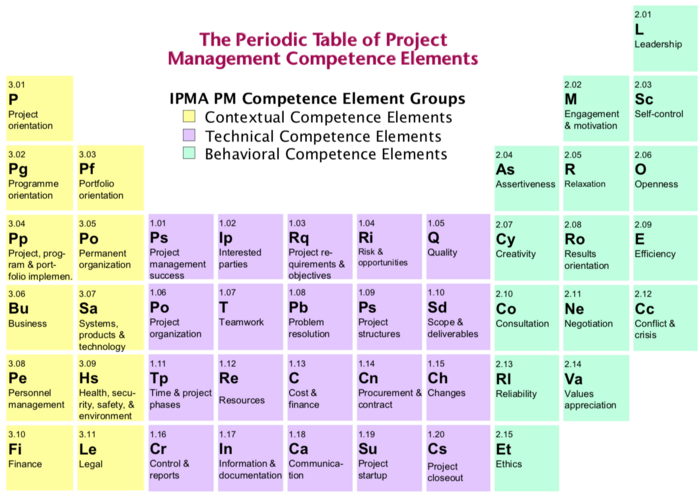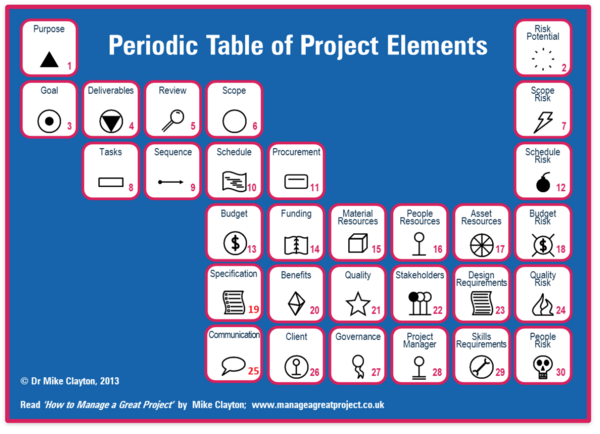The Periodic Table of Project Management
Developed by Brynja Benediktsdóttir - Under construction
Contents |
Abstract
This article will discuss the field of project management and different ways used to divide the field into smaller parts in order to obtain good oversight in projects. The possibility to make a periodic table for project management to acquire oversight in projects will be explored and two different versions of tables for project management will be presented. The periodic table of project management competence elements developed by the international project management association (IPMA) and the periodic table of project elements developed by Dr. Mike Clayton. The most famous periodic table is the periodic table of chemical elements that have been used and developed for 150 years. The biggest reason for its success is that it is useful for both scientists and modern students as it helps to predict the types of chemical reactions for its elements. Only by looking at the table many characteristics of elements can be determined which is one of the key factors for its wide usage all over the world. [1] With this much success of one periodic table, it raises the question if this could be done for other fields to simplify the content and display it in a table where a glance would tell several characteristics of the content (elements). The article will first discuss project management and two different methods that are used to divide the field of project management up in order to get an overview of a project. Next, the periodic table of chemical elements and the reasons for its wide distribution and usage across the globe will be explored and finally, are two periodic tables of project management examined.
Project Management
Projects are a valuable component to increase profits and benefits in organizations. The modern world is changing rapidly, and managers need to be able to stay on top with less budget and shorter timelines. Therefore, are companies embracing project management to remain competitive, staying consistent and deliver business value. In order for projects to succeed a certain number of factors have to be fulfilled and depending on the project along with its requirements, the factors can vary between projects. Each project is considered to have six performance aspects, often called the six vital signs, that need to be managed. The aspects are costs, time, quality, scope, risk, and benefits. The goal of project management is to meet project requirements by applying knowledge, skills, tools, and techniques to project activities. It is necessary to accomplish appropriate application and integration of the processes identified for the project which enables the execution to become effective and efficient. To be able to deliver the desired results standards are used to guide the project manager/team in the right direction by covering all the aspects of a project. Two project management standards will be examined with a focus on how the field of project management can be divided into sections to facilitate and simplify the work for management teams. [2][3]
The Project Management Knowledge Areas
The project management institute (PMI) standard divides project management into 10 areas of specialization which are generally used when managing projects. Each area has a distinct topic within project management that contains a set of processes. In the standard it is mentioned that the knowledge areas are used on most projects most of the time however, as each project is unique, it may require an additional knowledge area depending on the project. This demonstrates that the standard tries to cover all projects with the knowledge areas, but it is in the hands of project managers to identify relevant knowledge areas for their projects. The 10 project management knowledge areas covered in the PMI standard are:Cite error: Closing </ref> missing for <ref> tag
The Periodic Table of Project Management Competence Elements
The table made by the International Project Management Association (IPMA) contains 46 elements to illustrate the essential factors for project management. The factors displayed are more than only knowledge factors, they are competence factors that project managers can use to provide confirmation of performance with their portfolio. The elements are divided into 3 groups: contextual competence elements, technical competence elements, and behavioral competence elements.

Contextual competence elements
On the left side of the table, the contextual elements are shown in yellow. These elements contribute considerably to provide the competencies needed to overcome the risks in projects.
Technical competence elements
In the middle the key parts of the table, the technical elements, are displayed in purple. They correspond to the project management knowledge areas and are without a doubt essential to any project’s success. Nevertheless, does the table displaying the competence elements not only the knowledge elements. This category shows that the periodic table is more detailed than the six vital signs, the seven prince2 themes and the ten knowledge areas.
Behavioral competence elements
Finally, the behavioral elements are shown on the right side in green. They seem often neglected in project management baselines despite the fact that IPMA considers them to have a greater impact on project success than all the technical elements together.
The Role of Knowledge

To seek the desired outcome in a project the performance competence needs to be at its best. The IPMA standard embraces performance competence by moving beyond knowledge. In order to achieve the desired performance in a project the knowledge must be used right and can be demonstrated in steps leading to the performance. With only knowledge, nothing is accomplished even though knowledge is an important foundation. As knowledge is applied, a skill develops, and something gets accomplished during this phase. Skill has a longer lifetime then knowledge and when demonstrated skill is rewarded and recognized the learning tends to move to the next step, attitudes. New learning tends to continue as attitudes are strengthen when rewarded and recognized. Combining attitudes with more soft skill, the behaviors and interpersonal skill, the individual develops along with other new technical skills. When an individual is not able to obtain these skills, it results in people not willing to work with the individual. Focusing only on one skill without combining it to relevant behavioral elements will lead to long term success. After acquiring the attitudes and behavioral skills the next step is competence. This skill is measurable in projects, as it is demonstrated by project managers how the combination of knowledge, skill, attitudes, behaviors, and experience has been mastered. Different situations call for different approaches and project managers show their competence by being flexible and adapt that combination accordingly to each project. All these steps are essential inputs for project management success however the ultimate results desired is the project performance which the steps lead to if done according to each project. Heimild: Diff context – stacy goff
The Periodic Table of Project Elements
Another periodic table inside the field of project management is the periodic table of project elements where components in project management are thought of as elements and put in a table.

The table was made by Dr. Mike Clayton in order to celebrate the publishment of his book. When the table is compared to the periodic table of project management competence elements it relates more to the function of the original periodic table of chemical elements. The columns (groups) are elements that correspond to each other and is seen very clearly in column 9 which would simply be called risks and contains various types of risks that can occur in the project process. Column 1 seems to be the fundamentals of a project where purpose and goal are grouped together. By going from column to column, a linkage can be found between elements along with an appropriate name. The rows (periods) seem to have been categorized in steps of a project. Where in the first step the tasks are to define the purpose of the project and estimate potential risks. The second step is to define the goal, identify the deliverables, review and scope the project and identify the scope risks. The steps then continue one by one.
Discussion
The purpose of a periodic table is to have all the elements easily accessible at one place where the arrangement of the table can describe the properties of the elements in the table as well as undiscovered elements that could be added in the future. For the field of project management, it is highly unlikely that many elements are left undiscovered as the amount of completed, complex projects in the world that did not have any precursor are extremely many. However, as the field is very wide and covers different areas it is possible that terms that are used today could be divided into more detailed elements which would help the understanding of the term.
When comparing the project management knowledge areas from PMI and the PRINCE2 themes to the periodic tables it appears that the periodic table of project management competence elements goes beyond knowledge and displays how to seek the desired results. The table displays the competence elements in a unique way which is easily accessible and covers all the knowledge areas and themes from both standards. It is also explained in the role of knowledge how the knowledge is elevated to embrace performance competence.
The periodic table of project elements is made more for fun rather than practical use. It divides project management into elements similar to the standards. A good relation is between elements both in the columns and the rows which can be helpful in project work. Even though it is made more for fun it has the potential of becoming a useful tool if developed further.
Annotated Bibliography
Refrences
- ↑ https://www.thoughtco.com/why-is-the-periodic-table-important-608829 A.M. Helmensteine. Why Is the Periodic Table Important? Retrieved 09-02-2019.
- ↑ Project Management Institute. (2017). A guide to the project management body of knowledge (PMBOK® Guide). 6th ed. Pennsylvania: Project Management Institute.
- ↑ AXELOS A. Managing Successful Projects with PRINCE2 2017 Edition. London: The Stationery Office Ltd; 2017.
- ↑ Cite error: Invalid
<ref>tag; no text was provided for refs namedStacy - ↑ Cite error: Invalid
<ref>tag; no text was provided for refs namedMike